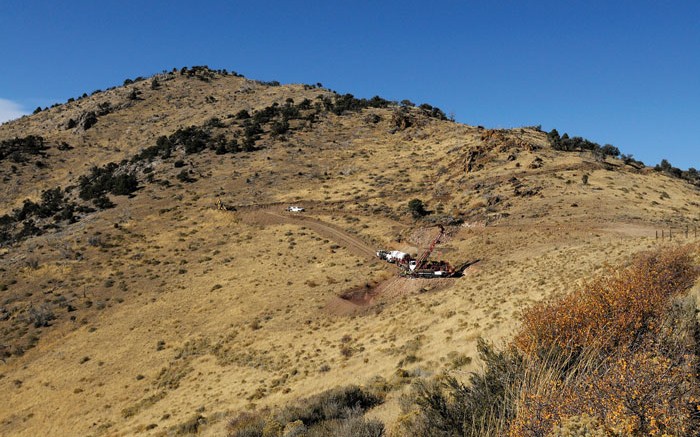Goldcorp (TSX: G; NYSE: GG) has become the second gold miner in less than a year to take a strategic stake in Gold Standard Ventures (TSXV: GSV; NYSE-MKT: GSV) and its Railroad land package in Nevada.
The gold major is acquiring 16.1 million shares for $1 per share in exchange for a 9.9% stake in the junior, which has amassed the second-largest land package on the gold-rich Carlin Trend after Newmont Mining (NYSE: NEM).
The private placement follows an investment by OceanaGold (TSX: OGC) in May 2015, in which the miner acquired a 14.9% stake in Gold Standard Ventures in exchange for $16.2 million. The Australia-headquartered company can also acquire up to 19.9% of the junior.
Jonathan Awde, Gold Standard Ventures’ president and CEO, describes both investments as a validation of the exploration success the company has had at the Railroad-Pinion project, and particularly noteworthy given the challenging market environment.
“The market for the last four years for any precious metal story … has been really challenging, and for us to get that financing done [with OceanaGold] at that time and in the context of that market spoke volumes about the work the team has done, and the land package,” Awde says in an interview.
“To have Goldcorp come in … one of the biggest gold producers in the world … it puts Gold Standard in a good financial position, and now we have $40 million in the bank.”
Under the latest transaction, Goldcorp has anti-dilution rights to keep its equity ownership interest, as well as the right to participate in future equity financings to acquire up to a 19.9% ownership position in Gold Standard Ventures.
The company’s first big gold discovery on the Railroad land package was the North Bullion sulphide gold deposit in 2011. Metallurgical tests at North Bullion indicate the mineralization is conducive to roaster processing, with 79–90% gold recoveries. High-grade drill intercepts from North Bullion include 124 metres grading 4.05 grams gold per tonne and 98.1 metres grading 3.26 grams gold.
Gold Standard followed up the discovery by acquiring the historic Pinion oxide gold deposit — 10 km south of North Bullion — in 2013 and 2014.
Pinion has a National Instrument 43-101 compliant indicated resource of 20.8 million tonnes grading 0.63 gram gold per tonne for 423,000 contained oz. gold at a 0.14 gram gold cut-off grade, with inferred resources adding 55.9 million tonnes grading 0.57 gram gold for 1.02 million contained oz. gold.
About 2.1 km east of Pinion lies Gold Standard’s Dark Star oxide gold deposit, which has an inferred resource of 23.1 million tonnes grading 0.51 gram gold per tonne for 375,000 oz. gold, using a cut-off grade of 0.14 gram gold per tonne.
Proceeds from Goldcorp’s private placement will be used to expand the 6 km Dark Star corridor, where the company recently discovered the North Dark Star target.
Last November, two drill intercepts from North Dark Star, 515 metres north of the Dark Star deposit, returned 149.4 metres grading 1.38 grams gold in hole 15-10, and 157 metres grading 1.51 grams gold in 15-11.
“We look to aggressively drill Dark Star and that whole corridor, and offset drill at Pinion and further step out there,” Awde says when asked how the company plans to use some of its $40-million war chest. “The resource is definitely open for expansion. The focal point is the Dark Star corridor, which is open for a lot of opportunity.”
Mike Carew of Haywood Securities points out in a research note to clients that Gold Standard’s view is that “Pinion and Dark Star may exhibit many of the same geological and metallurgical characteristics of Emigrant, a run-of-mine, heap-leach operation owned by Newmont Mining, 16 km north of Pinion-Dark Star, although further drilling — and metallurgical testing in particular — are required to support this interpretation.
“We see the results of metallurgical test work from Pinion and Dark Star as milestones to determine the recovery characteristics of gold-bearing material from Pinion and Dark Star,” he added, along with their similarities with Emigrant.
It has taken years for Gold Standard to consolidate its 115 sq. km land package at the southern end of Nevada’s Carlin Trend.
“Prior to Gold Standard’s involvement, land concessions within the Railway-Pinion area were controlled by several landowners, resulting in limited exploration work,” Haywood’s Carew noted. “Having all concessions under single ownership is critical not only in terms of consolidating potential gold resources, but to enable geologists to visualize and interpret mineralization at both Pinion and Dark Star as one project.”
News of Goldcorp’s strategic stake sent Gold Standard’s shares up 6¢, or 6.7%, to 96¢ per share. At press time the company traded at 94¢, within a 52-week range of 40¢ to $1.08.
As for the recent rally in the gold price, Awde says the industry has negative interest rates to thank.
“You’ve seen a fundamental shift in central banks around the world, where they’ve gone away from quantitative easing to a negative interest rate environment, and this is supporting the move in gold,” he says. “Historically, negative interest rate environments have been really strong for gold.”


Be the first to comment on "Goldcorp invests in Gold Standard Ventures"